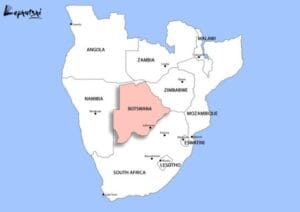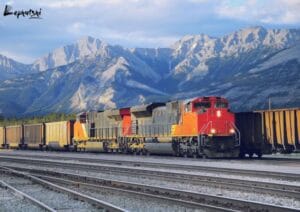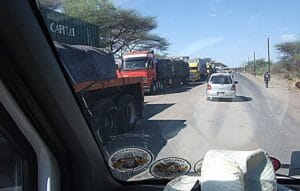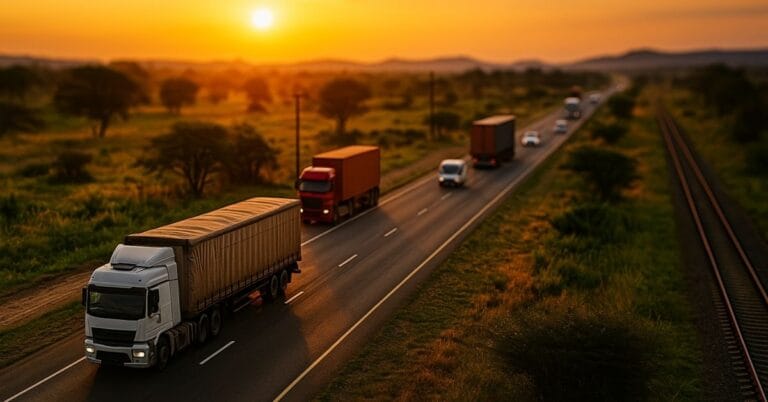Botswana sits right in the heart of Southern Africa — a strategic spot that links east–west and north–south trade routes between the Atlantic and Indian Oceans. Being landlocked means the country depends heavily on efficient inland networks and strong partnerships with its coastal neighbors to move goods. When all these systems work together, Botswana becomes more than just a participant — it’s a bridge that connects the region’s trade. For local exporters, importers, and logistics companies, this network is what keeps goods flowing and economies growing.
This guide walks you through how Botswana’s transport and logistics system actually works today. You’ll learn about the main transport modes, key corridors, border posts, and the critical role played by ports like Walvis Bay and Durban. We’ll also look at the digital tools improving customs, and where the biggest opportunities and challenges lie. For global context, check out the World Bank’s Logistics Performance Index, which tracks infrastructure and customs efficiency in 139 countries, including Botswana.

Key Sectors in Botswana’s Transportation
Picture Botswana’s transport system as a skeleton — solid bones connected by important joints. The “bones” are the road and rail lines running north to south along the A1 and BR main line. The “joints” are the borders and corridors connecting these routes to the outside world — like the Trans Kalahari highway to Walvis Bay or the A1 into South Africa. Add in the air routes that handle fast, high-value cargo and you get a system that, when managed right, lowers costs and keeps trade smooth.
Road Transport – The Backbone of Botswana’s Connectivity
Most goods in Botswana move by road — it’s flexible, quick to arrange, and reaches everywhere. The A1 corridor links key cities like Lobatse, Gaborone, Palapye, Serowe, and Francistown, while the A2 and Trans Kalahari routes stretch west to Namibia or south to South Africa. Trucks dominate long-haul trade, especially for container imports from Durban or Gqeberha. When timing is crucial, road transport always wins.
The Trans Kalahari Corridor is one of Southern Africa’s most vital trade arteries, connecting the Port of Walvis Bay to Botswana and South Africa’s Gauteng. Since its opening in 1998, it’s been a preferred west-coast route for shippers looking to avoid congested southern ports.
To make this corridor faster, Botswana and Namibia launched the One Stop Border Post (OSBP) pilot at Mamuno in 2024. The idea is simple — clear goods for both countries at one point. According to Botswana Daily News and NamRA, the system is already showing positive signs of shorter wait times and smoother traffic flow.
Rail Transport – Moving Bulk Goods Across Borders
When it comes to heavy freight, rail is king. Botswana Railways’ main line runs from Ramatlabama at the South African border through Gaborone and Francistown to Plumtree on the Zimbabwe side. It’s the go-to for moving mining inputs and bulk exports. In 2023, Statistics Botswana reported rail freight volumes topping one million tons, with revenue on the rise — all available in their Transport & Infrastructure Statistics Report.
Rail investments also look promising. Plans like the Mmamabula–Lephalale line aim to connect Botswana’s coal and bulk freight to South Africa’s export routes at Richards Bay. Early 2025 reports noted progress on capacity upgrades and track improvements on both sides of the border — small steps, but important ones for a sustainable logistics backbone.

Air Transport – Facilitating Trade and Tourism
Air transport may handle less cargo, but it moves the most valuable shipments — electronics, pharmaceuticals, and urgent spares. Gaborone’s Sir Seretse Khama International Airport is the main hub, while Maun and Kasane serve the booming safari and tourism markets. Passenger traffic has rebounded steadily post-pandemic, according to the Civil Aviation Authority of Botswana.
In early 2025, the government set aside P351 million for aviation infrastructure upgrades — boosting airport capacity, safety, and efficiency (African Pilot). For exporters of high-value or perishable goods, these upgrades mean faster, more reliable air freight operations.
Maritime Reliance – Partnerships with Neighboring Ports
Botswana’s lack of a coastline makes its partnerships with coastal ports essential. Durban and Gqeberha (South Africa) have long been the primary gateways for imports and exports, with many goods entering Botswana as re-exports through South African distributors (Trade.gov).
Walvis Bay, however, is becoming a serious west-coast alternative. The Walvis Bay Corridor Group has built a strong network linking Namibia’s port with Botswana and other SADC countries. For many businesses, the decision now isn’t “Durban or Walvis Bay?” — it’s “Which port gets my goods there faster?”
Trade Corridors and Border Posts You Should Know
Trans Kalahari Corridor, the West-Coast Express
This 1,900-kilometer fully paved highway links Walvis Bay to Johannesburg, cutting straight through Botswana. It’s one of the most efficient west-coast routes for container trucks and fuel tankers. Though a connecting rail link between Namibia and Botswana never took off, the road corridor remains a powerhouse for regional trade (details here).
The new OSBP at Mamuno is the latest upgrade, cutting wait times and improving coordination between both countries (NamRA notice | Daily News).
Kazungula Bridge, the Northern Gateway
The iconic Kazungula Bridge connects Botswana and Zambia over the Zambezi River. Before it opened in 2021, trucks queued for hours waiting for the ferry. Now, with the new 923-meter bridge and One Stop Border Post on both sides, traffic flows faster into Zambia and the DRC. Read more on SADC and Wikipedia.
Pioneer and Other South African Border Posts
Most of Botswana’s trade crosses into South Africa, and border efficiency makes or breaks the supply chain. Upgrades at Pioneer and other high-traffic crossings have improved clearance times. If your trucks use these routes, always check with your clearing agent to keep your documentation aligned with new procedures.
Customs, Permits, and the Digital Tools That Save Time
Even with great roads, border paperwork can cause delays. Botswana’s big win here has been digitization.
- Single Electronic Window: Traders can now submit all permits and licenses online through the BURS e-customs system. This cuts paperwork loops and lets you track progress in real time (Trading Portal announcement).
- Time Release Studies: The World Customs Organization worked with Botswana on a Time Release Study at Mamuno to measure and speed up border clearances (WCO report).
- Road Transport Permits: Carriers can apply and renew permits online through the Department of Road Transport and Safety. Forms and requirements are available on Gov.bw and Botswana Laws.
Using these digital tools, plus smarter scheduling and OSBP processes, can shave days off delivery times — a big win for logistics margins.
Growth Opportunities for Botswana’s Transport Industry
Botswana’s logistics sector is evolving fast. Here are four areas driving growth:
1) Infrastructure and Corridor Upgrades
Improved road surfaces, better signaling on rail, and modernized border facilities all lead to smoother movement. While these may sound like technical details, they directly impact shipping costs and delivery times. Projects across 2024–2025 show consistent investment in key transport corridors.
2) Regional Trade Integration
Since ratifying the AfCFTA in 2023, Botswana’s logistics policies now align with broader continental goals. That means more predictable tariffs, rules of origin, and new opportunities for regional value chains (Trade.gov).
3) Digital Logistics and Data Transparency
Tools like GPS tracking, e-PODs, and predictive ETAs are becoming standard. The real edge comes when agencies share performance data publicly — something Botswana is moving toward through its customs and border digitalization projects.
4) Sustainability and Cost Efficiency
Diesel and downtime are expensive. Fleet operators are investing in cleaner engines, driver training, and route optimization. While electric freight trucks are still in early stages locally, even small efficiency steps save thousands in annual costs.

Overcoming Challenges in Botswana’s Transport Sector
No logistics system is perfect — here’s what operators need to stay ahead of:
- Landlocked Limits: Port congestion in Durban or weather delays on the coast can ripple inland. Many businesses now keep backup port routes to stay flexible.
- Border Variability: Staffing changes or power outages can cause sudden slowdowns. Keep pre-clearance checklists and maintain active contact with agents on both sides.
- Maintenance and Last-Mile Roads: Rural and feeder roads still need improvement. Factor in longer times or delivery premiums for remote areas.
- Rail Capacity: Rail remains cost-effective but sometimes inconsistent. Work closely with Botswana Railways to secure reliable slots and clear scheduling expectations.
For a broader look at logistics challenges, see Trade.gov’s Market Challenges.
Future Outlook and Government Initiatives
Here’s a practical checklist for anyone planning trade routes in or through Botswana:
- Choose a main port — compare Durban and Walvis Bay on transit time and reliability.
- Understand One Stop Border Post procedures at Mamuno and Kazungula.
- Use BURS e-customs for online permit submissions.
- Plan rail transport for heavy freight early and align with BR schedules.
- Explore AfCFTA benefits for regional sourcing and exports.
- Account for seasonality, especially during Botswana’s tourism peaks.
The government’s long-term vision, led by the Ministry of Transport and Public Works, centers on infrastructure, digital systems, and public-private partnerships. This approach, combined with AfCFTA’s trade framework, positions Botswana as a more connected and competitive logistics hub.
Meanwhile, the Walvis Bay Corridor Group continues to strengthen westward links, ensuring that Botswana has multiple reliable trade routes to global markets.

What the Benchmarks Say
Global benchmarks like the World Bank’s Logistics Performance Index don’t tell the full story, but they give perspective. The 2023 update added real-time shipment data to measure customs and timeliness more accurately. Botswana’s steady reforms and corridor efficiency improvements are reflected in these evolving scores.
Conclusion: Botswana on the Move
Botswana’s logistics transformation is happening in real time — from faster clearance at Mamuno to stronger air cargo flows in Gaborone. The combination of digital customs, better roads, and regional trade integration is making cross-border trade smoother and more affordable.
If you work in logistics, freight forwarding, or e-commerce, this is the time to position your brand for regional visibility. Build a dual-port strategy, digitize your document flow, and plug into Botswana’s growing network.
Want to reach more customers? List your logistics or transport business on Lephutshi — Botswana’s Online Business Directory. Your listing makes it easier for clients to find, compare, and contact you directly.
Recommended Reading
1. World Bank Logistics Performance Index and the full 2023 report.
2. Trade.gov guides on distribution, agreements, and market challenges.
3. Ministry of Transport and Public Works for infrastructure projects and frameworks.
4. Walvis Bay Corridor Group for corridor insights and updates.
5. WCO Time Release Study on Botswana’s OSBP developments.
The four principal modes are road, rail, air, and maritime reliance through partnerships with neighboring coastal ports.
Yes. Though landlocked, Botswana leverages strategic road and rail connections, along with supportive government policies, to position itself as a growing regional logistics center.
Key challenges include lack of direct port access, border delays, and infrastructure maintenance requirements. Collaboration with neighbors and ongoing modernization help mitigate these constraints.
Government-led initiatives focus on upgrading road networks, modernizing rail systems, expanding major airports, introducing policy reforms, and cooperating with neighboring ports to streamline maritime access.
Exploring Botswana’s Transport & Logistics
— Lephutshi (@lephutshibw) October 14, 2025
Botswana is evolving into a regional logistics hub via upgraded highways, rail connections & collaborative port access.
Read more: https://t.co/kASQoCo4k8 #Botswana #Logistics #FreightandShipping #InfrastructureDevelopment

